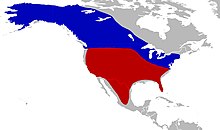| Columbian mammoth Temporal range:
| |
|---|---|

| |
| Composite male skeleton in the Page Museum at the La Brea Tar Pits | |
| Scientific classification | |
| Domain: | Eukaryota |
| Kingdom: | Animalia |
| Phylum: | Chordata |
| Class: | Mammalia |
| Order: | Proboscidea |
| Family: | Elephantidae |
| Genus: | †Mammuthus |
| Species: | †M. columbi
|
| Binomial name | |
| †Mammuthus columbi (Falconer, 1857)
| |

| |
| Approximate North American ranges of the Columbian mammoth (red) and woolly mammoth (blue) during the Late Pleistocene inferred from fossil finds | |
| Synonyms | |
|
List
| |
The Columbian mammoth (Mammuthus columbi) is an extinct species of mammoth that inhabited North America from southern Canada to Costa Rica during the Pleistocene epoch. The Columbian mammoth descended from Eurasian steppe mammoths that colonised North America during the Early Pleistocene around 1.5–1.3 million years ago, and later experienced hybridisation with the woolly mammoth lineage. The Columbian mammoth was among the last mammoth species, and the pygmy mammoths evolved from them on the Channel Islands of California. The closest extant relative of the Columbian and other mammoths is the Asian elephant.
Reaching 3.72–4.2 m (12.2–13.8 ft) at the shoulders and 9.2–12.5 t (9.1–12.3 long tons; 10.1–13.8 short tons) in weight, the Columbian mammoth was one of the largest species of mammoth, larger than the woolly mammoth and the African bush elephant. It had long, curved tusks and four molars at a time, which were replaced six times during the lifetime of an individual. It most likely used its tusks and trunk like modern elephants—for manipulating objects, fighting, and foraging. Bones, hair, dung, and stomach contents have been discovered, but no preserved carcasses are known. The Columbian mammoth preferred open areas, such as parkland landscapes, and fed on sedges, grasses, and other plants. It did not live in the Arctic regions of Canada, which were instead inhabited by woolly mammoths. The ranges of the two species may have overlapped, and genetic evidence suggests that they interbred. Several sites contain the skeletons of multiple Columbian mammoths, either because they died in incidents such as a drought, or because these locations were natural traps in which individuals accumulated over time.
For a few thousand years prior to their extinction, Columbian mammoths coexisted in North America with Paleoindians – the first humans to inhabit the Americas – who hunted them for food, used their bones for making tools, and possibly depicted them in ancient art. Columbian mammoth remains have been found in association with Clovis culture artifacts; these remains stemmed from hunting as well as possibly scavenging. The last Columbian mammoths are dated to about ~12,000 years ago, with the species becoming extinct as part of the end-Pleistocene extinction event, simultaneously with most other large (megafaunal) mammals present in the Americas. It is one of the last recorded North American megafauna to have gone extinct. The extinction of the Columbian mammoth and other American megafauna was most likely a result of habitat loss caused by climate change, hunting by humans, or a combination of both.